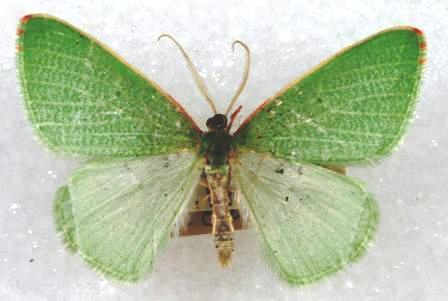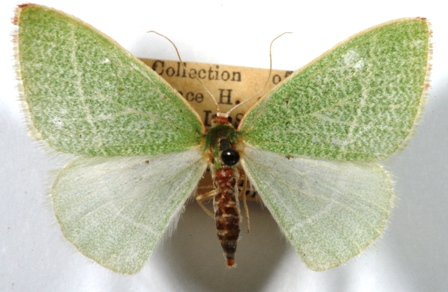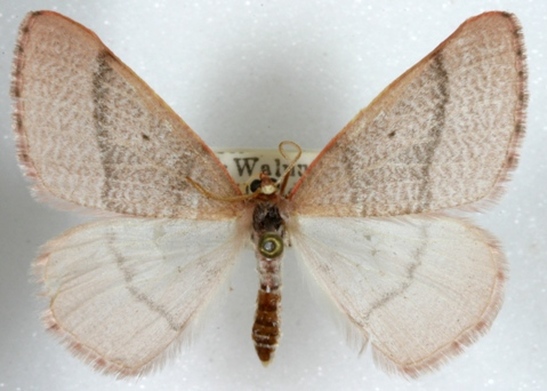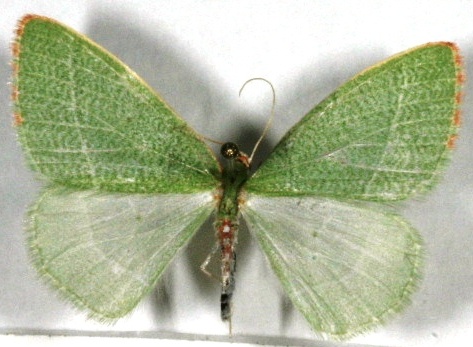Nemoria pulcherrima (Barnes & McDonnough, 1916). [7016]
Nemoria pulcherrima is particularly interesting among North American species in the genus Nemoria. It possesses several features that separate it from other species in the group and align it in somewhat more closely to the genus Chlorosea. Flying chiefly in the cooler months of the year, most commonly from January to April, this species is known primarily from California and Oregon where it is found in coastal mountain ranges.
Outwardly, the species is easily recognized by its bright green forewings and notably paler hindwings. This difference in wing coloration is common in species of Chlorosea, and is know in certain southwestern Nemoria species like N. viridicaria, N. diamesa and N. albaria, but is not present in any other Nemoria species found in California. Nemoria pulcherrima may have a green terminal line or edge border adjacent to fringes that are also green beyond a paler white base. Bright red markings may occur on the fringes, especially near the apical angle of the forewings. The wing surfaces are finely but widely striated with white markings, and often show whitish coloration on the wing veins creating a soft white venation pattern on the green wing. The pm line markings may be present as a pale, notably straight white line, though this is often obsolescent or entirely lacking. The dorsal surface of the abdomen is marked with two distinct white spots encircled by bright red scales. Nemoria pulcherrima has also been collected in a red-brown color form. A pdf copy of a paper by Buckett and Sears (1968) with images of the brown form can be viewed online here: Variation in Color and Maculation in a Population of Nemoria pulcherrima from the Sierra Nevada of California.
Ferguson (1985) reported that the male genitalia most closely resemble the genitalia of Chlorosea species. He also pointed out that the hind tibia spurs exist as two pair as in other Nemoria, though they may appear to be a single pair since the first set is recessed and can be hard to see without careful inspection. Immature stages are highly elaborated and are shown here:
Nemoria pulcherrima larvae.
Outwardly, the species is easily recognized by its bright green forewings and notably paler hindwings. This difference in wing coloration is common in species of Chlorosea, and is know in certain southwestern Nemoria species like N. viridicaria, N. diamesa and N. albaria, but is not present in any other Nemoria species found in California. Nemoria pulcherrima may have a green terminal line or edge border adjacent to fringes that are also green beyond a paler white base. Bright red markings may occur on the fringes, especially near the apical angle of the forewings. The wing surfaces are finely but widely striated with white markings, and often show whitish coloration on the wing veins creating a soft white venation pattern on the green wing. The pm line markings may be present as a pale, notably straight white line, though this is often obsolescent or entirely lacking. The dorsal surface of the abdomen is marked with two distinct white spots encircled by bright red scales. Nemoria pulcherrima has also been collected in a red-brown color form. A pdf copy of a paper by Buckett and Sears (1968) with images of the brown form can be viewed online here: Variation in Color and Maculation in a Population of Nemoria pulcherrima from the Sierra Nevada of California.
Ferguson (1985) reported that the male genitalia most closely resemble the genitalia of Chlorosea species. He also pointed out that the hind tibia spurs exist as two pair as in other Nemoria, though they may appear to be a single pair since the first set is recessed and can be hard to see without careful inspection. Immature stages are highly elaborated and are shown here:
Nemoria pulcherrima larvae.




